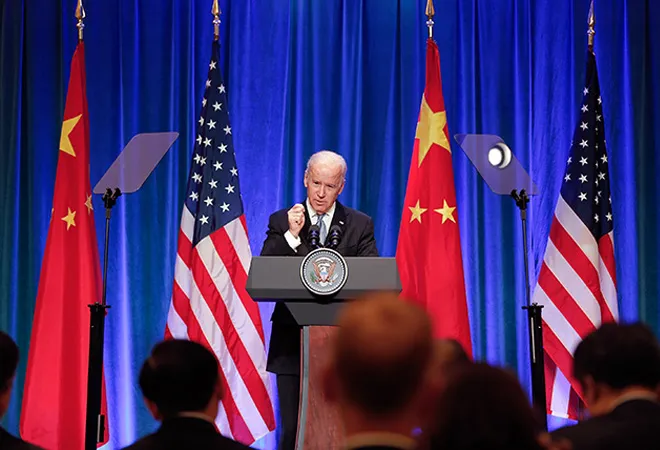
Last month, the Joe Biden administration oversaw the
inaugural meeting of the Blue Dot Network’s (BDN) Executive Consultation Group, as part of US efforts to have the Organisation for Economic Cooperation and Development (OECD) help design BDN’s certification framework. To contrast the '
Free and Open Indo-Pacific' vision from China’s predatory practises under the Belt and Road Initiative (BRI), the Donald Trump administration had established the BDN with like-minded nations, to offer a “
globally recognised seal of approval” for transparent and sustainable infrastructure finance.
Similarly, Biden’s Secretary of State, Antony Blinken, recently
chaired the first board meeting of the US International Development Finance Corporation (DFC), another Trump-era institution meant to execute the 'Free and Open Indo-Pacific’ vision by “
incentivising private investment as an alternative to a state-directed investment model.” Biden’s continuity on these initiatives stems from his proclivity for multilateralism, as evidenced with his administration’s aim to “
mobilise the full potential” of the Trump-era development finance tools under the recently announced Build Back Better World (B3W) Partnership between G7 nations.
By acknowledging that “
the best China policy really is a good Asia policy”, Biden officials have also underscored continuity with the previous administration’s region-wide disposition, which gave rise to the ‘Free and Open Indo-Pacific’ vision despite Trump’s ‘America First’ inclinations.
By acknowledging that “the best China policy really is a good Asia policy”, Biden officials have also underscored continuity with the previous administration’s region-wide disposition, which gave rise to the ‘Free and Open Indo-Pacific’ vision despite Trump’s ‘America First’ inclinations.
Points of continuity with Trump
Similarly, on the bilateral level with China, Biden has not revoked Trump’s tariffs on Chinese goods and continued to demand compliance on the ‘Phase One’ agreement, which included Chinese assurances to raise imports of American goods and services by
at least US $200 billion. Continuing the Trump-era push for a “
fair and reciprocal” trading arrangement, the Biden administration has rationalised its own focus on “
China’s unfair and market-distorting industrial policies” by citing its “
worker-centered trade policy”.
On China’s technological propositions, Biden has built on Trump’s November 2020 order (
EO 13959), which noted China to have exploited US capital towards the “development and modernisation of its military, intelligence, and other security apparatuses”. Biden’s
June 2021 executive order now imposes prohibitions on US investments in 59 Chinese defence and surveillance technology firms. Under Biden, the Federal Communications Commission has also built on the
Trump-era regulation against dealing with Huawei and ZTE, to formally
declare five Chinese companies (including Huawei and ZTE) as threats to US national security.
In addition, Secretary Blinken has
practised continuity with the Trump administration’s characterisation of Chinese actions in Xinjiang as a “genocide”, and has met
Uyghur activists, survivors and family members of victims. The Biden administration has also continued the Trump
precedent of gradually conditioning US-China economic ties as per China’s human rights record, for the first time since the Bill Clinton administration
ended the mandate of annually reviewing the ‘Most Favoured Nation’ status for China as per its progress on civil-liberties.
The Trump administration’s
2020 Xinjiang Supply Chain Business Advisory had warned against supply chain links to Chinese entities complicit in forced labour, and issued a detention order on cotton products produced by the Xinjiang Production and Construction Corps. Similarly, the Biden administration has
updated the Trump-era advisory, announced a
'whole of government' effort to include multiple federal agencies as signatories, and issued a ban on imports from the
Dalian Ocean Fishing Co. Ltd. and
Hoshine Silicon Industry Co. Ltd. on account of their use of forced labour.
The Trump administration’s 2020 Xinjiang Supply Chain Business Advisory had warned against supply chain links to Chinese entities complicit in forced labour, and issued a detention order on cotton products produced by the Xinjiang Production and Construction Corps. Similarly, the Biden administration has updated the Trump-era advisory, announced a 'whole of government' effort to include multiple federal agencies as signatories, and issued a ban on imports from the Dalian Ocean Fishing Co. Ltd. and Hoshine Silicon Industry Co. Ltd. on account of their use of forced labour
Discontinuing Trump’s vilification of China
However, Biden has deviated from the Trump-era singular focus on China as an exporter of the “
authoritarian governance model”, in terms of its “
influence and control of technology” undermining not only the freedoms of its “
own citizens, but all citizens of the world.” Following the G7 Summit, Biden defined the struggle against techno-authoritarianism in
broader terms: “I think we are in a contest, not with China per se, but a contest with autocrats, autocratic governments around the world.” Beyond rhetoric, this broader threat conception was evident on a policy level, with Biden’s June 2021 decision to
drop the Trump-era executive order on banning TikTok and WeChat. Biden instead called on the Commerce Department to launch new reviews of applications linked to all adversaries of the US.
In addition, Biden has discontinued the Trump administration’s “
implied calls for regime change” in China. Biden officials have
evidently refrained from directly vilifying the Chinese Communist Party (CCP), which was championed by Trump officials like Secretary of State Mike Pompeo (“
It is the party that is fomenting the challenge, not the hundreds of millions of Chinese”).
The Biden administration has instead sought to communicate with CCP officials. Beyond
engaging with his counterpart, Chinese Foreign Minister Wang Yi, Secretary Blinken has reportedly held
conversations with Yang Jiechi (CCP Politburo Member and Director of the Office of the Foreign Affairs Commission) on varied issues riddling US-China ties. Similarly, US Secretary of Defence Lloyd Austin
reportedly issued multiple requests for talks with General Xu Qiliang (member of the Political Bureau of the CCP Central Committee and Vice Chairman of the Central Military Commission), apart from Chinese defence minister Wei Fenghe.
Rectifying Obama’s approach on US-China ties
This rightsizing of continuity on the bilateral level may not necessarily imply a reduction in the Biden administration’s political will to confront or compete with China, especially since an emergent US bipartisan consensus against China stands underpinned with a
groundswell in anti-China sentiment (roughly nine-in-ten US adults (89 percent) now
consider China a competitor/enemy).
Instead, the reduction in outright vilification of China and the CCP pertains to recognising its
counterintuitive effect, in terms of only bolstering the CCP’s position amidst greater “Western interference” and spurring Beijing to “take even more ambitious actions abroad, to the detriment of U.S. interests and broader peace and security throughout Asia.”
The record of the Barack Obama administration stands as a testament to this supposition. Like Trump, Obama exercised direct vilification of China, with his administration’s
early imposition of tariffs on Chinese tires,
preemptive attribution of the US’ Air-Sea Battle (ASB) operational concept to a military confrontation with China,
classification of the need to resolve competing claims in the South China Sea as a matter of US “national interest”, and its
demand that China should “face consequences and international condemnation” for its abuse of internet freedoms.
This arguably led to China becoming
more assertive in staking its claims in the South China and East China Seas, with its 2012 declaration of administrative units over the former and its 2013 announcement of an Air Defence Identification Zone over the latter.
In hindsight, the Obama administration’s early vilification of China was not only counterintuitive, but also premature — without the push for a
region-wide consciousness against Chinese propositions. Moreover, the Obama administration’s attempt with the ‘Pivot to Asia’ strategy to inculcate greater regional realpolitik on China’s rise, was deemed to have been “
half-hearted” and little more than a push for defending the US-centric status-quo.
In hindsight, the Obama administration’s early vilification of China was not only counterintuitive, but also premature — without the push for a region-wide consciousness against Chinese propositions. Moreover, the Obama administration’s attempt with the ‘Pivot to Asia’ strategy to inculcate greater regional realpolitik on China’s rise, was deemed to have been “half-hearted” and little more than a push for defending the US-centric status-quo.
Subsequently, even that limited effort was undercut, in view of the US’ overriding intent to cooperate with China over global governance issues, like climate change and Iran’s nuclear programme. This informed the Obama administration’s ambivalence towards China flouting its
commitment against militarising the South China Sea,
reconceptualisation of the ASB to the Joint Concept for Access and Manoeuvre in the Global Commons (JAM-GC) to also include the Persian Gulf, and the removal of the Pivot policy’s aim of “
forging a broad-based military presence” from the succeeding ‘
Rebalance to the Asia-Pacific’ policy’s mandate.
Whereas, Trump’s abhorrence for multilateralism accorded him the latitude to engage in outright vilification of China, without inviting Obama’s fate of reversing course on his focus on confronting the Chinese. However, as Biden also seeks to cooperate with China — primarily over
raising commitments under the Paris Agreement, his administration risks repeating the Obama-era misstep of undervaluing the criticality of advocating a vision for the region’s development.
Thus, even as Biden tempers his continuity on Trump’s policies by reducing the vilification of China, the internationalisation of the ‘Free and Open Indo-Pacific’ vision with the BDN-OECD and the B3W partnerships indicates his cognisance of Obama’s folly.
The views expressed above belong to the author(s). ORF research and analyses now available on Telegram! Click here to access our curated content — blogs, longforms and interviews.



 Last month, the Joe Biden administration oversaw the
Last month, the Joe Biden administration oversaw the  PREV
PREV


